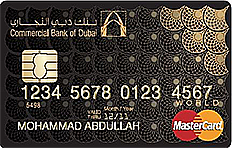Best Balance Transfer Credit Cards in UAE
Credit cards may help you in overcoming your debts; however, sometimes they might also put you under a burden of debt. Paying back your credit card debt can be difficult, especially if all you have been paying is minimum payments monthly.
In these situations, you can opt for the facility of balance transfer on your credit card in UAE. Nowadays, you will easily come across various banks that offer balance transfer credit cards in UAE, which lets you transfer the outstanding balance from one bank account to another.
We have compiled a list of some of the top balance transfer cards in UAE for you.
Top 6 Balance Transfer Credit Cards for April 2025 in UAE
1. Emirates NBD MasterCard Titanium Credit Card
This Emirates card gives you the option to enjoy a host of features & benefits. These features & benefits may include golf offers, access to airport lounges, reward points, several discounts, and many more. This credit card is amongst the leading ones in the balance transfer category.

-
Minimum Salary AED 5000
-
Annual Fee AED 400
- Airport Lounge Access
- Dining Discounts
- Golf Benefits
2. CBD World MasterCard Credit Card
This credit card by Commercial Bank of Dubai promises to provide you with a host of special privileges and amazing experiences. You can enjoy features and benefits such as CHIP & PIN, access to airport lounges, balance transfer, CBD rewards, and more.
The balance transfer option on this card can be availed in two options- regular and revolving balance transfer.

-
Minimum Salary AED 25,000
-
Annual Fee AED 787.50
- Airport Lounge Access
- Movie Discounts
- Dining Discounts
- Valet Discounts
- Free for 1st year
- Revolving Balance Transfer Processing Charges: 100 dirhams or 4 percent (the higher one)
- Regular Balance Transfer Rate of Interest: Up to 0.89 percent monthly (flat)
- Revolving Balance Transfer Cancellation Fees: 2 percent on the balance remaining
- Annual Charges: 750 dirhams (1st year free)
- Retail Finance Charges: 3.45 percent monthly
3. HSBC Advance Credit Card
With this HSBC card, you can enjoy air miles in the form of rewards and a free Entertainment App by HSBC. You also get to enjoy a wide collection of travel and lifestyle benefits that include hotel discounts, airport lounge free access, and much more.
Being amongst the best balance transfer credit cards, it allows you to enjoy balance transfer facility at reducing interest rate monthly, zero percent for the balance transfer plan term. Here are the fees charged on this facility.

-
Minimum Salary AED 10,000
-
Annual Fee Free For Life
- Free for Life
- Airport Lounge Access
- Movie Discounts
- Valet Parking
- On six months’ plan: 1.50 percent or 100 dirhams (the higher one)
- On 12 months’ plan: three percent or 100 dirhams (the higher one)
- On 24 months’ plan: six percent or 100 dirhams (the higher one)
4. ADIB Value Credit Card
This ADIB card allows you to earn rewards on domestic as well as international spends. You can enjoy a world of privileges and benefits such as complimentary flight tickets, vouchers at shopping malls, and a maximum discount of 25 percent on selected restaurants throughout UAE, and many more.

-
Minimum Salary AED 5,000
-
Annual Fee Free For Life
- Free for Life
- Dining Discounts
- Special Discounts
5. RAKBANK Red Credit Card
If you want to pay less on your shopping, then this RAKBANK credit card can be ideal for you. It allows you to save time using contactless technology. Moreover, you can also stay protected with amazing features such as coverage for travel accident, credit shield, purchase protection, and more.

-
Minimum Salary AED 5,000
-
Annual Fee Free For Life
- Free for Life
- Dining Discounts
- Special Discounts
You can also transfer funds using the RAKMoney Transfer facility. The balance transfer facility on this card can be availed at a certain interest rate.
- Retail Finance Charges: 3.45 percent monthly
- Interest Rate for Balance Transfer: 1.50 percent monthly
- Early settlement or cancellation fee on balance transfer: 249 dirhams
6. First Abu Dhabi Bank Etihad Guest Platinum Credit Card
This credit card comes with unique sign-up benefits for you along with other benefits such as airport transfers, earning Etihad guest miles, movie offers, discounts on golf, facility for money transfer, shopping offers, and much more. Moreover, this FAB credit card also provides protection benefits including extended warranty, credit shield, and purchase protection.

-
Minimum Salary AED 8,000
-
Annual Fee AED 500
- Special Discounts
You have the option of settling your outstanding balances on credit cards with other banks within the Emirates by transferring the balances to this credit card.
- Annual Charges: 500 dirhams
- Retail Finance Charges: 3.50 percent monthly
- Transfer up to 90 percent of the pre-decided credit limit
Top 5 Balance Transfer Credit Cards in UAE for April 2025
| Bank | Credit Card Name | Annual Fee (AED) | Minimum Salary (AED) |
|---|---|---|---|
| CBD | CBD Super Saver | 420 | 8000 |
| Emirates NBD | Emirates NBD Lulu Mastercard Titanium | Free for Life | 5000 |
| FAB | FAB Elite Infinite | Free for Life | 40000 |
| HSBC | HSBC Zero Credit Card | Free for Life | 10000 |
| United Arab Bank | United Arab Bank Visa Titanium | 300 | 6000 |
| Click here to Apply for Best Balance Transfer Credit Card in UAE |
| Global Village Ticket Offer on Credit Card |
Summary on Best Balance Transfer Credit Card
If you wish to clear off your credit card debts but are not able to do so, then balance transfer credit cards in UAE can be a good option. In this article, we have listed some of the top credit cards under this category.
However, you must keep in mind that the list is not ranked as any order. You must always select the card that compliments your lifestyle requirements the best.
More From Credit Cards
- Recent Articles
- Popular Articles















